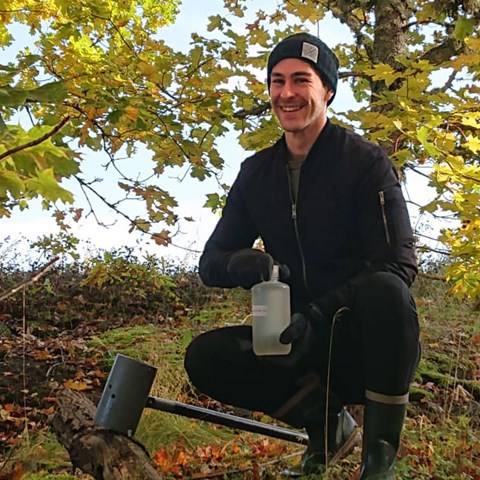The environment receives chemical environmental contaminants from a variety of sources. These include a release during production, a lack of knowledge about the consequences of intentional or unintentional releases to the environment, etc. But what happens when these contaminants enter the environment, and how do plants and animals react?
Daniel Malnes, a PhD student at the Swedish University of Agricultural Sciences (SLU), has studied the effects of chemical contaminants in freshwater. The chemicals are dispersed by the flow of water, and since water is so important for humans, animals, and nature, the chemicals there are important to study. This is why Daniel dedicated his work to mapping and studying which environmental contaminants are particularly concerning.
Daniel has focused his studies on environmental contaminants with properties that make them particularly important to monitor. These are environmental pollutants that have the ability to resist degradation in the freshwater environment, are mobile in water, and are potentially also toxic.
Mapping of chemicals in important waters
With the starting point in environmental contaminants found in earlier studies of freshwaters in Europe, Daniel has studied the occurrence of these contaminants in Sweden’s three largest lakes and their associated watercourses.
Various environmental pollutants end up in the water along the route where the tributaries to the lakes flow. The contaminants might come from wastewater treatment plants which are often positioned close to rivers.
- The wastewater treatment plants’ effluents are being mixed into the watercourses in various concentrations of different environmental contaminants. With the direction of the flow, these environmental contaminants reach the lakes where the contaminants mix and the contaminants that are resistant to degradation will remain in the lakes for an extended period of time. This is clear from the results of my work, Daniel Malnes says.
In addition to investigating which environmental contaminants occur in inlets and lakes, the study also included monitoring the watercourses that are the lakes' outlets. A total of 23 watercourses and three lakes were included in the study.
- It then becomes clear which contaminants are mobile in the freshwater environment and resist degradation in the aquatic environment, something that can affect the aquatic ecosystem for an extended period of time. This is unfortunate, as these lakes carry many important societal values. The lakes and rivers have, for example, protection-worthy ecosystems with organisms that provide important ecosystem services, and the lakes are also national interests as raw water sources for producing drinking water, Daniel says.
Variation of the occurrence
Besides being able to show which contaminants occur and in what concentration, the studies indicate that there are clear seasonal variations in the occurrence of environmental contaminants. Previous studies have been able to demonstrate a difference in concentrations at wastewater effluents, but not in the watercourses and lakes that receive this wastewater. This makes the study presented by Daniel particularly important.
Seasonal variation was shown to be associated with certain contaminants and groups of contaminants. UV filters from sunscreens, for example, were found in the watercourses mainly during the summer. Bactericidal parabens with anti-mold properties were mainly found in the spring. The seasonal variation is verified by correcting for the watercourse's varying flow.
- The seasonal variations can be driven by use patterns of products, for example, the purchases of sunscreens or antihistamines, but also seasonal variations of contaminant degrading bacteria or sunlight, says Daniel.
Important work and further research on environmental contaminants
Many of the environmental contaminants included in the study are difficult to remove from the water in the wastewater treatment plants with existing technology. Therefore, there is also important work to be done in the future with the implementation of treatment technologies at wastewater treatment plants, etc., but also legislation on, for example, how the substances may be used. In order to find alternatives to reduce the presence of environmental contaminants in the environment, further research is also needed to gain knowledge about how it affects ecosystems and humans. Since products can have a large geographical spread and water crosses national borders, international cooperation is important to continue working to improve the aquatic environment.

Number of environmental contaminants in hazardous concentrations, for which ecotoxicological data were available. The environmental contaminants were divided into (i) which time perspective (acute and chronic) and (ii) the risk (RQ>1 more probable than RQ>0.01) the environmental contaminants were exceeding environmentally hazardous concentrations. River sites were subdivided according to which lake the sites were associated with. R: river sites. RQ: risk quotients.

